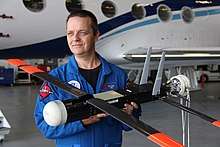Raytheon Coyote
The Raytheon Coyote is a small, expendable, unmanned aircraft system built by the Raytheon Company, with the capability of operating in autonomous swarms. It is launched from a sonobuoy canister with the wings deploying in early flight phase.
| Coyote | |
|---|---|
_credit-_NOAA.jpg) | |
| Coyote UAS on test flight in 2016 | |
| Role | Small, expendable unmanned aerial vehicle |
| National origin | United States |
| Manufacturer | Raytheon |
| Introduction | 2014 |
| Status | Operational |
| Primary user | National Oceanographic and Atmospheric Administration |
The system can operate up to one hour and is designed for interchangeable payloads. It is used by the National Oceanographic and Atmospheric Administration (NOAA) for hurricane tracking,[1] and is being assessed by the United States Air Force and Army as an intelligence, surveillance, and reconnaissance asset, as well as for delivering kinetic payloads.[2]
Design and development
A company named Advanced Ceramic Research, of Tucson, Arizona, originally developed the Coyote, Manta and Silver Fox UAS under small business contracts from the U.S. Office of Naval Research. British defense contractor BAE Systems acquired the company in 2009, then sold it back to one of the former owners under the name Sensintel. Raytheon acquired Sensintel in 2015 and folded the company into its Tucson-based Missile Systems business.[3][4]
The Coyote first flew in 2007 while still under ACR development, being launched from a Beechcraft C-12 Huron.[5]
C-UAS
The U.S. Army is developing the Coyote Block 2 with a counter unmanned air system (C-UAS) capability to intercept other small UAVs. The Coyote Anti-UAS delivers a kinetic effect by crashing into enemy drones or exploding near them and dispersing blast fragments from its warhead.[4][6][7] By 2018, the U.S. Marine Corps was deploying a C-UAS that had been in development for two years. The Ground-Based Air Defense (GBAD) Counter-UAS system consists of the RPS-42 S-band radar, the Modi electronic warfare system, visual sensors and the Coyote anti-drone UAV to detect, track and destroy hostile drones. The system can operate out of a forward operating base or from vehicles such as an M-ATV or a pair of MRZR off-road vehicles.[8] In July 2018, Raytheon announced the Army had awarded it a contract to deliver the Coyote for C-UAS missions, with deliveries starting by the end of the year. The Coyote Block 1B is equipped with an RF seeker and proximity warhead and works in conjunction with Raytheon’s Ku band radio frequency system (KRFS) radar; the system is capable of intercepting Class I and II drones. Raytheon is also developing a Block 2 variant equipped with a jet engine, improving speed and loiter time to engage larger and further targets.[9][10][11] The Coyote Block 2 features improved sensors and a turbine engine to make it four times faster than its predecessor.[12] In June 2019, the Coyote-KRFS radar system, dubbed Howler C-UAS, achieved Initial Operational Capability with the U.S. Army after just 17 months of development.[13]
Operational history
The Coyote is launched from a NOAA P-3 Hurricane Hunter aircraft, and provides NOAA hurricane forecasters with real-time data on atmospheric air pressure, temperature, moisture, wind speed and direction as well as surface temperature. The Coyote collects this essential data at altitudes too low for manned aircraft to safely navigate in the hurricane environment.[14] Its first operational deployment was an investigation of Hurricane Edouard on 16 September 2014.[15]
Specifications

- Airspeed: 55 knots (102 km/h) cruise, 70 knots (130 km/h) kts dash[15]
- Deployment altitude: up to 30,000 feet (9,100 m) MSL (in non-icing conditions)
- Comms range: 50 nautical miles (93 km) (May 2016); 70 nautical miles (130 km) (ground test October 2016)
- Endurance: 1 hr+ @ cruise (May 2016); 2h (2017)
- Weight: 13 pounds (5.9 kg)
- Length: 36 inches (0.91 m) [16]
- Wingspan: 58 inches (1.5 m)
- Cost: $20,000 per drone [17]
References
| Wikimedia Commons has media related to Raytheon Coyote. |
- "Coyote UAS". Raytheon Company. Retrieved 2017-09-23.
- Geoff Fein (16 January 2017). "Surface Navy 2017: Coyote earmarked for ISR and offensive roles". IHS Jane's International Defence Review. Retrieved 2017-09-24.
- "Raytheon's enhanced Coyote UAV flies into hurricanes for NOAA". Raytheon. 20 January 2016. Retrieved 2017-09-24.
- "Raytheon Further Develops Multi-Mission Coyote UAS". AIN Online. 21 June 2017. Retrieved 2017-09-25.
- "BAE Systems' Coyote UAV flies". Flight Global. 21 January 2010. Retrieved 2017-09-25.
- Army and Air Force's Coyote UAV for ISR and Offensive Roles. Real Clear Defense. 16 January 2017.
- Army's air, missile defense countering UAS threat in multiple ways. Army.mil. 29 March 2018.
- Marines Forward-Deploy Portable Drone-Killing System. USNI News. 4 June 2018.
- Army to Buy Raytheon's Coyote Expendable UAS for Drone-Killing Mission. Defense Tech. 17 July 2018.
- Raytheon to Provide Army with Drones for Killing Other Unmanned Systems. National Defense Magazine. 17 July 2018.
- Army, Navy Buy Raytheon’s Coyote Drone Weapon. Breaking Defense. 17 July 2018.
- How to Defeat a Drone Attack: Raytheon Shows Off New Tech in Tabletop Exercise. Military.com. 24 January 2020.
- US Army Deploys Howler C-UAS System into Battlefield. UAS Vision. 20 June 2019.
- "NOAA and Raytheon improve unmanned aircraft to collect hurricane weather data". NOAA. 12 January 2016. Retrieved 2017-09-24.
- Joseph J. Cione (25 October 2016). "The Coyote Unmanned Aircraft System" (PDF). NOAA. Retrieved 2017-09-24.
- "BAE Systems/Sensintel Coyote". UAVGlobal. Retrieved 2017-09-24.
- "Raytheon drones flung into Hurricane Maria to gather data". Arizona Daily Star. Retrieved 2019-11-15.